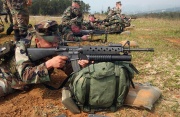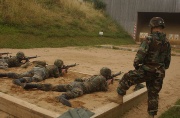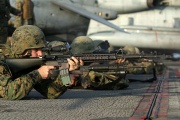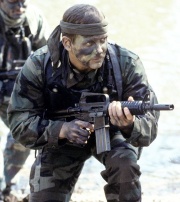M16 rifle
| Rifle, 5.56 mm, M16 | |
|---|---|

| |
| M16A1, M16A2, M4, M16A4, from top to bottom | |
|
| |
| Type | Assault rifle |
| Land of Origin | United States |
| Specifications | |
| Length | 39.5 in (1,000 mm) |
| Barrel length | 20 in (508 mm) |
| Weight | 8.5 lb (3.9 kg) |
| Caliber | 5.56mm |
| Cartridge | 5.56x45mm NATO |
| Action | Gas-operated, rotating bolt |
|
| |
| Rate of Fire | 800-900 rounds/min, cyclic depending on model |
| Muzzle velocity | 3,200 ft/s (975 m/s) (M16A1)
3,050 ft/s (930 m/s) (M16A2) |
| Effective Range | 550 m (600 yd) |
| Max. Range | 3600 m |
| Feed | Various STANAG Magazines. |
| Service History | |
| In service | 1961–present |
| Used by | USA, at least 73 other users |
| Wars | Vietnam War-present |
| Production History | |
| Designer | Eugene Stoner & L. James Sullivan |
| Design Date | 1957 |
| Manufacturer | Colt Manufacturing and Fabrique Nationale Manufacturing Inc. (primaries) |
| Unit Cost | USD$586[1] |
| Produced | 1960-present |
| No. Built | Approx. 8 million |
| Variants | See #Variants |
The M16 (more formally Rifle, Caliber 5.56 mm, M16) is the U.S. military designation for a family of rifles derived from the ArmaLite AR-15 and further developed by Colt starting in the mid-20th century.
The M16 rifle family including the M16/A1/A2/A3/A4 has been the primary infantry rifle of the United States military since the 1960s. With its variants, it has been in use by 15 NATO countries, and is the most produced firearm in its caliber. The M16 entered Army service in 1964.
Contents[hide] |
[edit] Introduction
The M16 is a lightweight, 5.56 mm caliber, air-cooled, gas-operated, magazine-fed rifle, with a rotating bolt, actuated by direct impingement gas operation. It is constructed of steel, aluminum and composite plastics.
The US Air Force M16 and the US Army's XM16E1 were the first versions fielded. The XM16E1 was soon standardized as the M16A1. The M16A1 was simply the M16 with a forward assist feature requested by the Army. All early versions fired the M193/M196 cartridge in semi- or full-automatic modes. This took place in the early 1960s, with major fielding by the Army in late 1964. Commercial AR-15s were first issued to Special Forces troops in the spring of 1964.[2]
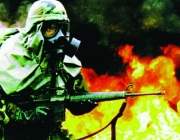
The M16A2 entered service in the 1980s and fired the NATO standard Belgian-designed M855/M856 cartridge. The M16A2 is a select fire rifle capable of semi-automatic or three-round bursts and incorporating design elements desired by the Marine Corps. These features included an adjustable rear-sight for windage and elevation, a 5/8 inch longer buttstock, heavier barrel, case deflector for left-handed shooters, and rounded handguards. Mode of fire is determined by using a selector switch on the side of the weapon. The M16A3 was essentially an M16A2 with an M16A1 fire control group; this had only limited procurement by the USN.
The M16A4 became standard issue for the United States Marine Corps during Operation Iraqi Freedom, increasingly replacing the earlier M16A2. In the United States Army, a combination of the M16A4 and M4 Carbine have replaced the A2 as frontline rifles. The A4 incorporates a flattop receiver unit developed for the M4 Carbine, a handguard with four Picatinny rails for mounting optical sights, lasers, night vision devices, forward handgrips, removable carry handle and flashlights.
The M16 is primarily manufactured by Colt and Fabrique Nationale de Herstal, with variants produced by numerous countries around the world. Semi-automatic versions, generally referred to as "AR-15s" (because of Colt's purchase of the nomenclature from Armalite), are popular recreational firearms in the United States, with versions manufactured by a handful of larger manufacturers and over a dozen smaller concerns.
[edit] History
[edit] Summary
The M16 was an initial version first adopted in 1964 by the United States Air Force (USAF). The U.S. Army began to field the XM16E1 en masse in 1965 with most going to Vietnam. The US Marine Corps also adopted the system during this period. The XM16E1 was standardized as the M16A1 in 1967. This version remained the primary infantry rifle of the United States military from 1967 until the 1980s, when it was supplemented by the M16A2. During the early 1980s a roughly standardized load for this ammunition was adopted throughout NATO (see: 5.56 mm NATO).
The M16A3 is a fully-automatic variant of the M16A2, issued primarily within the United States Navy. The M16A2, in turn, is currently being supplemented by the M16A4, which incorporates the flattop receiver unit developed for the M4 Carbine, and Picatinny rail System. Previous versions of the weapon are still in stock and used primarily by reserve and National Guard units in the United States as well as by the U.S. Air Force.
[edit] Project SALVO
In 1948, the Army organized the civilian Operations Research Office (ORO), mirroring similar operations research organizations in the United Kingdom. One of their first efforts, Project ALCLAD, studied body armor and the conclusion was that they would need to know more about battlefield injuries in order to make reasonable suggestions. Over 3 million battlefield reports from WWI and WWII were analyzed and over the next few years they released a series of reports on their findings.
The conclusion was that most combat takes place at short range. In a highly mobile war, combat teams ran into each other largely by surprise; and the team with the higher firepower tended to win. They also found that the chance of being hit in combat was essentially random — that is, accurate "aiming" made little difference because the targets no longer sat still. The number one predictor of casualties was the total number of bullets fired. Other studies of behavior in battle revealed that many U.S. infantrymen (as many as 2/3) never actually fired their rifles in combat. By contrast, soldiers armed with rapid fire weapons (such as submachine guns) were much more likely to have fired their weapons in battle. These conclusions suggested that infantry should be equipped with a fully-automatic rifle of some sort in order to increase the actual firepower of regular soldiers. It was also clear, however, that such weapons dramatically increased ammunition use and in order for a rifleman to be able to carry enough ammunition for a firefight they would have to carry something much lighter.
Existing rifles were poorly suited to real-world combat for both of these reasons. Although it appeared the new 7.62 mm T44 (precursor to the M14) would increase the rate of fire, its heavy 7.62 mm NATO cartridge made carrying significant quantities of ammunition difficult. Moreover, the length and weight of the weapon made it unsuitable for short range combat situations often found in jungle and urban combat or mechanized warfare, where a smaller and lighter weapon could be brought to bear faster.
These efforts were noticed by Colonel René Studler, U.S. Army Ordnance's Chief of Small Arms Research and Development. Col. Studler asked the Aberdeen Proving Ground to submit a report on the smaller caliber weapons. A team led by Donald Hall, director of program development at Aberdeen, reported that a .22 inch (5.59 mm) round would have performance equal to larger rounds in most combat. With the higher rate of fire possible due to lower recoil it was likely such a weapon would inflict more casualties on the enemy. His team members, notably William C. Davis, Jr. and G.A. Gustafson, started development of a series of experimental .22 (5.56mm) cartridges. In 1955, their request for further funding was denied.
A new study, Project SALVO, was set up to try to find a weapon design suited to real-world combat. Running between 1953 and 1957 in two phases, SALVO eventually suggested that a weapon firing four rounds into a 20 in (508 mm) area would double the hit probability of existing semi-automatic weapons.
In the second phase, SALVO II, several experimental weapons concepts were tested. Irwin Barr of AAI Corporation introduced a series of flechette weapons, starting with a shotgun shell containing 32 darts and ending with single-round flechette "rifles". Winchester and Springfield offered multi-barrel weapons, while ORO's own design used two .22, .25 or .27 caliber bullets loaded into a single .308 Winchester or .30-06 cartridge.
[edit] Eugene Stoner
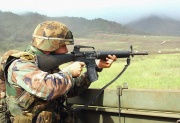
Meanwhile testing of the 7.62 mm T44 continued, and Fabrique Nationale also submitted their new FN FAL via the American firm of Harrington & Richardson as the T48. However, the results of the testing were apparently already a forgone conclusion; the T44 was selected as the new battle rifle for the U.S. Army (rechristened the M14) despite a strong showing by the T48.
Acceptance of the M14 did not occur before a newcomer entered the contest. In 1954, Eugene Stoner of the newly-formed ArmaLite helped develop the 7.62 mm AR-10. Springfield's T44 and similar entries were conventional rifles using wood for the "furniture" and otherwise built entirely of steel using mostly forged and machined parts. ArmaLite was founded specifically to bring the latest in designs and alloys to firearms design, and Stoner felt he could easily beat the other offerings.
Stoner's AR-10 was radical for its day. The receiver was made of forged and milled aluminum instead of steel. The barrel was mated to the receiver by a separate hardened steel adapter to which the bolt locked. This allowed a lightweight aluminum receiver to be used while still maintaining a steel-on-steel lockup. The bolt was operated by gases vented from the front of the barrel directly into a cylinder created in the bolt carrier with the bolt itself acting as a piston. Traditional rifles located this cylinder and piston close to the gas vent. The stock and grips were made of a fiberglass-reinforced plastic shell over a rigid foam plastic core. The muzzle brake was fabricated from titanium. Over Stoner's vehement objections, various experimental composite and 'Sullaloy' aluminum barrels were fitted to some AR-10 prototypes by ArmaLite's president, George Sullivan. The Sullaloy barrel was made entirely of heat-treated aluminum, while the composite barrels used aluminum extruded over a thin stainless steel liner.
Meanwhile the layout of the gun itself was also somewhat different. Previous designs generally placed the sights directly on the barrel, using a bend in the stock to align the sights at eye level while transferring the recoil down to the shoulder. This meant that the gun tended to rise when fired making it very difficult to control during fully-automatic fire. The ArmaLite team used a solution previously used on weapons such as the German FG42 and Johnson light machine gun; they located the barrel in line with the stock, well below eye level, and raised the sights to eye level. The rear sight was built into a carrying handle over the receiver.
The AR-10 was a very advanced design for its time. Despite being over 2 lb (0.9 kg) lighter than the competition, it offered significantly greater accuracy and recoil control. Two prototype rifles were delivered to the U.S. Army's Springfield Armory for testing late in 1956. At this time, the U.S. armed forces were already two years into a service rifle evaluation program, and the AR-10 was a newcomer with respect to older, more fully-developed designs. Over Stoner's continued objections, George Sullivan had insisted that both prototypes be fitted with composite aluminum/steel barrels. Shortly after a composite barrel burst on one prototype in 1957, the AR-10 was rejected. The AR-10 was later produced by a Dutch firm, Artillerie Inrichtingen, and saw limited but successful military service with several foreign nations like Sudan and mainly Portugal using quite a large quantity as sniper rifles during the war in Angola until 1975.
[edit] CONARC
In 1957, a copy of Gustafson's funding request from 1955 found its way into the hands of General Willard G. Wyman, commander of the U.S. Continental Army Command (CONARC). He immediately put together a team to develop a .22 caliber (5.56 mm) weapon for testing. Their finalized request called for a select-fire weapon of 6 pounds (2.7 kg) when loaded with 20 rounds of ammunition. The bullet had to penetrate a standard U.S. steel helmet, body armor, or a 0.135 inch (3.4 mm) steel plate and retain a velocity in excess of the speed of sound at 500 yards (460 m), while equaling or exceeding the "wounding" ability of the .30 Carbine.[3]
Wyman had seen the AR-10 in an earlier demonstration, and impressed by its performance he personally suggested that ArmaLite enter a weapon for testing using a 5.56 mm cartridge designed by Winchester. Their first design, using conventional layout and wooden furniture, proved to be too light. When combined with a conventional stock, recoil was excessive in fully automatic fire. Their second design was simply a scaled-down AR-10, and immediately proved much more controllable. Winchester entered a design based loosely on their M1 Carbine, and Earle Harvey of Springfield attempted to enter a design, but was overruled by his superiors at Springfield, who refused to divert resources from the T44.
In the end, ArmaLite's AR-15 had no competition. The lighter round allowed the rifle to be scaled down, and was smaller and lighter than the previous AR-10. The AR-15 weighed only around 5.5 lb (2.5 kg) empty, 6 lb (2.7 kg) loaded (with a 20 round magazine).
During testing in March 1958, rainwater caused the barrels of both the ArmaLite and Winchester rifles to burst, causing the Army to once again press for a larger round, this time at .256 in (7 mm). Nevertheless, they suggested continued testing for cold-weather suitability in Alaska. Stoner was later asked to fly in to replace several parts, and when he arrived he found the rifles had been improperly reassembled. When he returned he was surprised to learn that they too had rejected the design even before he had arrived; their report also endorsed the .256 in (7 mm) round. After reading these reports, General Maxwell Taylor became dead-set against the design, and pressed for continued production of the M14.
Not all the reports were negative. In a series of mock-combat situations testing the AR-15, M14 and AK-47, the Army found that the AR-15's small size and light weight allowed it to be brought to bear much more quickly, just as CONARC had suggested. Their final conclusion was that an 8-man team equipped with the AR-15 would have the same firepower as a current 11-man team armed with the M14. They also found that the AR-15, as tested, was more reliable than the M14, suffering fewer stoppages and jams in tests where thousands of rounds were fired.
At this point, Fairchild had spent $1.45 million in development expenses, and wished to divest itself of its small-arms business. Fairchild sold production rights for the AR-15 to Colt Firearms in December 1959, for only $75,000 cash and a 4.5% royalty on subsequent sales. In 1960, ArmaLite was reorganized, and Stoner left the company.
[edit] M16 adoption
Curtis LeMay viewed a demonstration of the AR-15 in July 1960. He immediately ordered 8,500 for defense at Strategic Air Command airbases, later rescinded by Defense Secretary Robert McNamara. Colt Industries also approached the Advanced Research Projects Agency (ARPA), who bought 1,000 rifles for use by South Vietnamese troops in the early summer of 1962. American special operations units and advisers working with the South Vietnamese troops filed battlefield reports lavishly praising the AR-15 and the stopping effectiveness of the 5.56 mm cartridge, and pressed for its adoption.
U.S. Secretary of Defense Robert McNamara now had two conflicting views: the ARPA report favoring the AR-15 and the Pentagon's position on the M14. Even President John F. Kennedy expressed concern, so McNamara ordered Secretary of the Army Cyrus Vance to test the M14, the AR-15 and the AK-47. The Army's test report stated only the M14 was suitable for Army use, but Vance wondered about the impartiality of those conducting the tests. He ordered the Army Inspector General to investigate the testing methods used, who reported that the testers showed favor to the M14.
Secretary Robert McNamara ordered a halt to M14 production in January 1964, after receiving reports that M14 production was insufficient to meet the needs of the armed forces. Secretary McNamara had long been a proponent of weapons program consolidation among the armed services. At the time, the AR-15 was the only rifle that could remotely fulfill a requirement of a 'universal' infantry weapon for issue to all services. McNamara ordered the weapon be adopted unmodified, in its current configuration, for immediate issue to all services, despite receiving reports noting several deficiencies with the M16 as a service rifle, including the lack of a chrome-lined bore and chamber, the 5.56 mm projectile's instability under Arctic conditions, and the fact that large quantities of 5.56 mm ammunition required for immediate service were not available. In addition, the Army insisted on the inclusion of a forward assist plunger to help push the bolt into battery in the event that a cartridge failed to seat in the chamber through fouling or corrosion. The original Armalite already had a chrome-lined chamber to prevent corrosion. Colt on the other hand, had argued the rifle was a 'self-cleaning' design, requiring little or no maintenance. Colt, Eugene Stoner, and the U.S. Air Force believed that a forward assist needlessly complicated the rifle, adding about $4.50 to its procurement cost with no real benefit. As a result, the design was split into two variants: the Air Force's M16 without the forward assist, and for the other service branches, the XM16E1 with the forward assist.
In November 1964, the Army ordered 85,000 XM16E1s for experimental use, and the Air Force ordered another 19,000. Meanwhile, the Army carried out another project, the Small Arms Weapons Systems (SAWS), on general infantry firearm needs in the immediate future. They highly recommended the immediate adoption of the weapon, so much so that they started referring to it as the M16. Later that year the Air Force officially accepted their first batch as the United States Rifle, Caliber 5.56 mm, M16.
The Army immediately began to issue the XM16E1 (re-named M16 on its adoption) to infantry units, and the rifle was initially delivered without adequate cleaning supplies or kit. Moreover, the Army's inability to deliver 5.56 mm ammunition meeting quantity and velocity specifications led to a change in powder specification for the 5.56 mm cartridge. The change was made without testing the modified ammunition in the rifle under service conditions; the newly-specified 5.56 ammunition increased the cyclic rate of fire, increasing wear on parts, and the new gunpowder's burning characteristics increased fouling in the M16 rifle.
When the XM16E1 reached Vietnam with U.S. troops in 1966, reports of jamming and malfunctions in combat immediately began to surface. Although the M14 had a chrome-lined barrel and chamber to resist corrosion in combat conditions (a danger learned from WWII Pacific theatre combat experience), the M16/XM16E1 had no chrome-lined bore or chamber. Several documented accounts of troops killed by enemy fire with jammed rifles broken-down for cleaning eventually brought a Congressional investigation. Later investigations also cast doubt on the veracity of the original 1962 reports of the alleged stopping effectiveness of the 5.56 mm bullet, as well as criticism of inadequate penetration (in comparison to the Soviet 7.62x39mm round) when firing at enemy personnel through light cover.
The XM16E1 was soon modified to the M16A1 specification. The revised rifle was finally given a chrome-lined bore and chamber to eliminate corrosion and stuck cartridges, and the rifle's bore and recoil mechanism was re-designed to accommodate Army-issued 5.56 mm ammunition. Rifle cleaning tools and powder solvents/lubricants were issued. The Army ordered 840,000 of this version on February 28, 1967. Intensive training programs in weapons cleaning were instituted, and a comic book style manual was circulated among the troops to demonstrate proper maintenance. The reliability problems of the M16 diminished quickly, although the rifle's reputation continued to suffer. Moreover, complaints about the inadequate penetration and stopping power of the 5.56 mm cartridge persisted throughout the Vietnam conflict.
[edit] NATO standardization
In March 1970, the Pentagon shocked other NATO nations by stating all U.S. forces assigned to NATO would be equipped with the M16A1. The British military was highly vocal in voicing its anger after adopting the 7.62 mm NATO round over their .280 caliber (7.1 mm) round nearly 20 years earlier. Now they were being told the U.S. recognized the need for such a caliber of firearm after all, and was willing to start the NATO standardization of a lighter round.
By the middle of the 1970s, other armies were also looking at an M16-style weapon. A NATO standardization effort soon started, and tests of various rounds were carried out starting in 1977. The U.S. offered their original design, the M193, with no modifications, but there were serious concerns about its penetration in the face of the wider introduction of body armor. The British offered a modified 5.56 mm round, using a longer and thinner bullet of 4.85 mm. The round had somewhat better ballistics, and considerably better penetration, able to reach 600 m and meet their requirements for a squad automatic weapon (light machine gun). The Germans proposed a new 4.7 mm caseless round, which was considerably lighter while offering similar ballistics to the original U.S. design. However, there was distrust in the caseless system due to the possibility of cook off. A final design was offered by the Belgians. Their SS109 round was based on the U.S. cartridge but included a new bullet design, with the same 5.56 mm caliber, but with a small steel tip added to improve penetration.
Testing soon showed that the British and Belgian designs were roughly equal, both outperforming the original U.S. design. In order to get full performance from tracer versions of the SS109, however, barrels would have to use different rifling. Existing 12 in (305 mm) twist barrels reduced the effective range of the SS109 to 90 meters due to lack of stability. While the ideal twist rate for the SS109 projectile is 9 in (229 mm), a 7 in (178 mm) twist rate was chosen to stabilize the much longer L110 tracer. This tracer was designed to complement the SS109's ballistic performance. The M196 tracer (complement to the M193 ball round) had a burn-out range of 450 meters where the L110 tracer was bright to 800 meters. In the end the Belgian round was chosen. The U.S. Marine Corps was first to adopt the round with the M16A2, introduced in 1982. This was to become the standard U.S. military rifle. The NATO standard ammunition produced for U.S. forces is designated M855 for the ball round using an SS109 type projectile and M856 for the tracer using the L110 type projectile.
Total worldwide production of M16-style weapons since the design's inception has been approximately 8 million.
[edit] Future replacement
[edit] Overview
In the 1980s, the new Squad Automatic Weapon M249 was issued to infantry units, replacing all M60s and some M16A1s at the squad level. In the 1990s the M4 Carbine took over the operational role of the obsolete M3 Grease Gun, some Beretta M9s, and many M16A2s. The US Air Force currently plans to replace all of its M16s with M4s, according to a 2004 presentation. The US Army and Marine Corps have largely relegated the M16A2 to non-combat roles, choosing instead the M16A4 and M4. Further, the M16 never entirely replaced the M14 in all roles, which continues to be used in a number of niche applications throughout the Armed Forces, especially with the US Navy.
Replacement of the M16 family has been proposed at various points, and its longevity is in part due to a series of failures in projects meant to replace it, driven largely by the requirement for a significant improvement. Immediately after the introduction of the M16, the Marine Corps sought to adopt the Stoner 63. Although they found it superior in most ways, it was still at an early stage of development; the Marines chose the technically inferior but mature M16. The Advanced Combat Rifle (ACR) program in the 1980s produced weapons that were superior in some ways, but none improved upon the M16 series enough to replace it. It was also potentially going to be replaced by the SABR, from the OICW project. The weapon system originally planned by the OICW project was put on hold around the turn of century, in favor of a simpler new 5.56 mm rifle project that offered less far-reaching improvements. The resulting XM8 rifle was also intended as a potential replacement for the M16 family. However, this program too ran into problems around 2004-5, and was put on hold in favor of a competition for what became known as the OICW Increment 1. This competition was subsequently put on hold in the summer of 2005 to take into account input from other services, and several months later was cancelled outright.
Another potential replacement for the M16 rifle is the Special Forces Combat Assault Rifle (SCAR) called the Mark 16 (MK 16). The 5.56x45 MK 16 emerged as the winner of a U.S. SOCOM competition to find a new rifle for Special Forces in 2003. Development by FN Herstal continues and introduction for special forces is expected in late 2007 or early 2008. The Mk.16 offers different length barrels for close quarters combat and for longer-range engagements. Most of the SCAR's basic controls (pistol grip, magazine release, selector lever, and bolt release) share the same location and function as on the M16 and M4 they are supplementing.
[edit] Background
Throughout the 1970s, the Army experimented with various materials to replace brass in cartridge casings. Brass has a number of features that make it almost ideal for a cartridge, including low friction against steel, making it easier to extract, and the ease of which casings can be manufactured. However, brass is also dense and expensive, so replacing it could lower both the cost and weight of the ammunition.
Aluminum and steel were popular materials for complete rounds, and AAI successfully developed a plastic blank. However, none of these materials ever entered production for a variety of reasons. Completely caseless ammunition was also studied on several occasions, notably the German 4.7 mm designs, but issues with reliability and "cook off" were never completely solved.
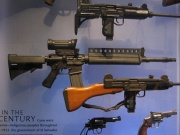
Later in the 1980s, the Advanced Combat Rifle program was run to find a replacement for the M16. The Army was pressing for a 100% increase in the ability for infantry to hit their targets, in the same way that SALVO had aimed to increase effectiveness by 100% through increased rate of fire.
Colt entered a modified M16A2 known as the Colt ACR, which used duplex rounds, a system that lowered recoil by 40% to improve repeating shots, and added a 3.5x scope. This weapon, designated M16A2E2, also featured a "guide" of sorts as part of a special handguard developed by the U.S. Army Human Engineering Laboratory (HEL) designed to assist in snap-shooting, and a carbine style stock very similar to the recent stock developed by the Naval Surface Warfare Center, Crane Division.
The Steyr ACR used new flechette ammunition that was nominally called 5.56 mm, with a very high 4,750 ft/s (1,448 m/s) muzzle velocity. Other variants experimented with caseless ammunition technologies as well.
Although they all offered some improvement, none came close to the benchmark set for the testing.
More recently, the Army started the XM8 system project for a radically improved weapon. However, the program was shelved in favor of an open competition for what became known as OICW Increment 1. (Increment 2 is the stand-alone airbursting grenade launcher known as the XM25, and Increment 3 will be the XM29, a weapon which combines the earlier two increments.) The OICW-1 competition was cancelled on October 31 2005.
[edit] Design details
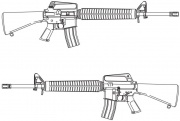
The M16's receivers are made of aluminum alloy, its barrel, bolt, and bolt carrier of steel, and its handguards, pistol grip, and buttstock of plastics. Early models were especially lightweight at 6.5 lb (2.9 kg). This was significantly less than older 7.62 mm "battle rifles" of the 1950s and 1960s. It also compares with the 11 lb (5 kg) (loaded) AK-47. M16A2 and later variants weigh more (8.5 lb (3.9 kg) loaded) because of the adoption of a thicker barrel profile. The thicker barrel is more resistant to damage when handled roughly and is also slower to overheat during sustained fire. Unlike a traditional "bull" barrel that is thick its entire length, the M16A2's barrel is only thick forward of the handguards. The barrel profile under the handguards remained the same as the M16A1 for compatibility with the M203 grenade launcher. The rifle is the same length as the M16A2.
One distinctive ergonomic feature is a plastic or metal stock directly behind the action, which contains a recoil spring. This serves the dual function of operating spring and recoil buffer. The stock being in line with the bore reduces muzzle rise, especially during automatic fire. Because recoil does not significantly shift the point of aim, user fatigue is reduced.
Another distinctive ergonomic feature is a carrying handle on top of the receiver where the rear sight is located. This design is a by-product of the original design where the carry handle served to protect the charging handle and mount a scope. In practice, the handle is rarely used to carry the weapon; holding the weapon by the pistol grip provides quicker response time while a shoulder sling provides a more convenient option when response time is not a concern. More importantly, with the sight plane 2.5 in (63.5 mm) over the bore, the M16 has an inherent parallax problem that can be confounding to shooters. At closer ranges (typically inside 15–20 meters), the shooter must aim high in order to place shots where desired.
Newer models have a "flattop" upper receiver with a Picatinny mounting rail, to which the user can attach either a conventional sighting system or numerous optical devices such as night vision scopes.
The M16 utilizes direct impingement gas operation; energy from high-pressure gas tapped from a non-adjustable port built into the front sight assembly actuates the moving parts in the weapon. Combustion gases travel via a gas tube above the barrel directly into a chamber in the bolt carrier behind the bolt itself, pushing the carrier away from the bolt. This reduces the number of moving parts by eliminating the need for a separate piston and cylinder and it provides better performance in rapid fire by keeping reciprocating masses on the same axis as the bore.
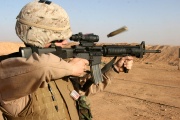
The primary criticism of direct impingement is that fouling and debris from expended gunpowder is blown directly into the breech. As the superheated combustion gas travels down the tube, it expands and cools, not unlike an aerosol can cool when depressurized. This cooling causes vaporized matter to condense as it cools depositing a much greater volume of solids into the operating components of the action. The increased fouling can cause malfunctions if the rifle is not cleaned as frequently as should be. The amount of sooting deposits tends to vary with powder specification, caliber, and gas port design.
[edit] Operation
The weapon is cleared by removing the magazine, pulling the charging handle to the rear, and inspecting the chamber. To load, the magazine is inserted into the well. To prepare the weapon for firing, the weapon is cocked by pulling the charging handle to the rear, and letting go to ensure the bolt closes properly. "Riding" the charging handle often causes the bolt to fail to close properly.
When the magazine is exhausted, the bolt locks to the rear; by replacing the empty magazine with a fresh one, and pressing the bolt release, a new round is chambered and the soldier may immediately commence firing.
In event of a stoppage while firing, soldiers in many countries are taught to perform the SPORTS drill immediately, without attempting to identify the cause of the stoppage. In this drill, the magazine is slapped to ensure that it is properly seated. The charging handle is pulled to the rear and the chamber is observed to ensure it is not fouled. The charging handle is released to chamber the round, the forward assist is tapped to ensure proper bolt closure, and the trigger is squeezed to fire.
[edit] Production and usage
The M16 is the most commonly manufactured 5.56x45mm rifle in the world. Currently, the M16/M4 system is in use by 15 NATO countries and more than 80 countries world wide. Together, the U.S. and Canada (as the C7) have produced more than 8,000,000 units with approximately 90% still in operation. [4]
In U.S. service, the M16 primarily replaced the M14 and M1 Carbine series as standard infantry rifles, and to a lesser extent, some of the jobs of the BAR Light automatic rifle. The M14 continues to see service, just not as the primary service rifle. It is used as a sniper rifle, designated marksman rifle and several smaller niche areas.
In addition to the United States of America (the country of origin), users of the M16 rifle and its variants have included and are: [5]
|
|
[edit] Variants
- For more details on M16 variants, see AR-15 variants
[edit] AR-15 (Colt Models 601 & 602)
- Main article: AR-15
Colt's first two models produced after the acquisition of the rifle from ArmaLite were the 601 and 602, and these rifles were in many ways clones of the original ArmaLite rifle (in fact, these rifles were often found stamped Colt ArmaLite AR-15). The 601 and 602 are easily identified by their "slab-sided" lower receivers without the commonly found "fencing" around the magazine well, and in certain cases their green or brown furniture. The 601 was adopted first of any of the rifles by the USAF, and was quickly supplemented with the XM16 (Colt Model 602) and later the M16 (Colt Model 604) as improvements were made. There was also a limited purchase of 602s, and a number of both of these rifles found their way to a number of Special Operations units then operating in South East Asia, most notably the U.S. Navy SEALs. The only major difference between the 601 and 602 is the switch from the original 1:14-inch rifling twist to the more common 1:12-inch twist.
[edit] M16
Variant originally adopted by the USAF. This was the first M16 adopted operationally. This variant had triangular handguards, a three-pronged flash suppressor, and no forward assist. Bolt carriers were originally chrome plated and slick-sided, lacking any notches for a forward assist. Later, the chrome plated carriers were dropped in favor of Army issued notched and parkerized carriers. The Air Force continues to operate these weapons and upgrades them as parts wear or break and through attrition.
[edit] XM16E1 and M16A1
The prototype army-version, XM16E1, was essentially the same weapon as the M16 with the addition of a forward assist. The M16A1 was the finalized production model. To address issues raised by the XM16E1's testing cycle, a "bird-cage" flash suppressor replaced the XM16E1's three-pronged flash suppressor, which was too easy for foreign material to get into and which caught on twigs and leaves. After numerous problems in the field, various changes were made. Cleaning kits were developed and issued; barrels with chromed chambers and later fully-chromed bores were introduced. The number of malfunctions due to fouling and corrosion declined and later troops were generally unfamiliar with early problems. A rib was built into the side of the receiver on the XM16E1 to help prevent accidentally pressing the magazine release button when closing the ejection port cover and perhaps also to protect the receiver from wear from the cover hitting up against it. This rib was later extended on production M16A1s to help in preventing the magazine release from inadvertently being pressed. The bolt cam pin and the hole it rides in the bolt were tapered to prevent the bolt from being inserted upside down (creating a failure to fire). The M16A1 remains in service in extremely limited numbers, mainly as a training aid. It has, however, been widely exported abroad.
[edit] M16A2
The development of the M16A2 rifle was originally requested by the United States Marine Corps as a result of the USMC's combat experiences in Vietnam with the M16 and M16A1. The Marines were the first branch of the US Armed Forces to adopt the M16A2 in the early/mid 1980s with the United States Army following suit in adopting the M16A2 in the late 1980s. Modifications to the M16A2 were more extensive. In addition to the new rifling, the barrel was made with a greater thickness in front of the front sight post to resist bending in the field, allow for cooling between shots, and the stepped-up design allowed use of the M203 grenade launcher to be used with the weapon. The front sight was now a square post with 4 detent positions in order to refine the sight picture. A new adjustable rear sight was added, allowing the rear sight to be dialed in for specific range settings between 300 and 800 meters to take full advantage of the ballistic characteristics of the new SS109 rounds and to allow windage adjustments without the need of a tool or cartridge. The flash suppressor was again modified, this time to be closed on the bottom so it would not kick up dirt or snow when being fired from the prone position, and acting as a recoil compensator.[6] The front grip was modified from the original triangular shape to a round one, which better fit smaller hands and could be fit to older models of M16s. The new handguards were also symmetrical so that armories needn't separate left and right spares. The handguard retention ring was angled to make it easier to install and uninstall the handguards. The pistol grip adds a notch for the middle finger and more texture to enhance the grip. The buttstock was lengthened by 5/8 inch (16 mm). The new buttstock is ten times stronger than the original due to advances in polymer technology since the early 1960s. Original M16 stocks were made from fiberglass-impregnated resin; current stocks are engineered from DuPont Zytel glass-filled thermoset polymers. The new stock includes a fully textured polymer buttplate for better grip on the shoulder, and retains a panel for accessing a small compartment inside the stock often used for storing a basic cleaning kit. The heavier bullet reduces muzzle velocity from 3,200 feet per second (975 m/s), to about 3,050 feet per second (930 m/s). The A2 also uses a faster twist rifling to allow the use of a trajectory-matched tracer round. A spent case deflector was incorporated into the upper receiver to prevent casings from striking left-handed users.
The action was also modified, replacing the fully-automatic setting with a three-round burst setting. When using a fully-automatic weapon, poorly trained troops often hold down the trigger and "spray" when under fire. The U.S. Army concluded that three-shot groups provide an optimum combination of ammunition conservation, accuracy and firepower. There are mechanical flaws in the M16A2 burst mechanism. The trigger group does not reset when the trigger is released. If the user releases the trigger between the second and third round of the burst, for example, the next trigger pull would only result in a single shot. Even in semi-automatic mode, the trigger group mechanism affects weapon handling. With each round fired, the trigger group cycles through one of the three stages of the burst mechanism. Worse, the trigger pull at each of these stages may vary as much as 6 lbf (27 N) in pressure differential, detracting from accuracy.
All together, the M16A2s new features added weight and complexity to the M16 series. Critics also point out that neither of the rear sight apertures is ideally sized. The smaller aperture was described as being too small, making quick acquisition of the front sight post difficult; and the larger aperture was described as being too large, resulting in decreased accuracy. To make matters worse, the rear sight apertures are not machined to be on the same plane. In other words, the point of impact changes when the user changes from one aperture to the other. The rear sight's range adjustment feature is rarely used in combat as soldiers tend to leave the rear sight on its lowest range setting: 300 meters. Despite criticism, a new rifle was needed both to comply with NATO standardization of the SS109 (M855) and to replace aging Vietnam era weapons in the inventory.
[edit] M16A3
The M16A3 was a fully-automatic variant of the M16A2 adopted in small numbers around the time of the introduction of the M16A2, primarily by the U.S. Navy for use by SEAL, SeaBee, and Security units.[7] It features a Safe-Semi-Auto (S-1-F) trigger group like that of the M16A1.
Some confusion continues to exist regarding the M16A3. It is often described as the fully-automatic version of the M16A4. Descriptions of the M16A3 that claim that it shares the M16A4's Picatinny rail are incorrect. This misunderstanding most likely stems from the usage of the A2 and A3 designations by Colt and other manufacturers of weapons before the official adoption of the M16A4. Many manufacturers of civilian AR15 rifles designate variants with flat top confirmations as "A3" rather than "A4." Colt used the "A3" designation in the hopes of winning military contracts as they also did with the terms, "M4" and "M5."
[edit] M16A4
The M16A4, now standard issue for front-line U.S. Marine Corps and some U.S. Army units, replaces the combination fixed carry handle/rear iron sight with a MIL-STD-1913 Picatinny rail, allowing for the rifle to be equipped with a carry handle and/or most military and consumer scopes or sighting systems.[7] Most of the U.S. Marine Corps' M16A4s are equipped with a Knight's Armament Company M5 RAS handguard, allowing vertical grips, lasers, tactical lights, and other accessories to be attached. In U.S. Army Field Manuals, M16A4s fitted with the RAS are sometimes referred to as M16A4 MWS or Modular Weapon System. This model retains the 3-round burst mode of the M16A2.[7]
[edit] Specialist variants
[edit] Colt Model 655 and 656 "Sniper" variants
With the expanding conflict in South East Asia, Colt developed two rifles of the M16 pattern for evaluation as possible light sniper or designated marksman rifles. The Colt Model 655 M16A1 Special High Profile was essentially a standard A1 rifle with a heavier barrel and a scope mount that attached to the rifle's carry handle. The Colt Model 656 M16A1 Special Low Profile had a special upper receiver with no carrying handle. Instead, it had a low-profile iron sight adjustable for windage and a Weaver base for mounting a scope, a precursor to the Colt and Picatinny rails. It also had a hooded front iron sight in addition to the heavy barrel. Both rifles came standard with either a Leatherwood/Realist scope 3-9x Adjustable Ranging Telescope. Some of them were fitted with a Sionics noise and flash suppressor. Neither of these rifles were ever standardized.
These weapons can be seen in many ways to be predecessors of the U.S. Army's SDM-R and the USMC's SAM-R weapons.
[edit] XM177, M4 Carbine, and Colt Model 733
- Main article: CAR-15
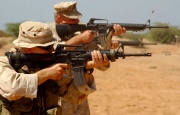
In Vietnam, some soldiers were issued a carbine version of the M16 called the XM177. The XM177 had a shorter 10 in (254 mm) barrel and a telescoping stock, which made it substantially more compact. It also possessed a combination flash hider/sound moderator to reduce problems with muzzle flash and loud report. The USAF's GAU-5/A (XM177) and the U.S. Army's XM177E1 variants differed over the latter’s inclusion of a forward assist. The final USAF GAU-5A/A and U.S. Army XM177E2 had an 11.5 in (292 mm) barrel with a longer flash/sound suppressor. The lengthening of the barrel was to support the attachment of Colt's own XM148 40 mm grenade launcher. These versions were also known as the Colt Commando model commonly referenced and marketed as the CAR-15. The variants were issued in limited numbers to special forces, helicopter crews, Air Force pilots, officers, radio operators, artillerymen, and troops other than front line riflemen.
- Main article: M4 carbine
The M4 carbine was developed from various outgrowths of these designs, including a number of 14.5 in (368 mm)-barreled A1 style carbines. The XM4 (Colt Model 720) started its trials in the mid-80s, with a 14.5-inch (368mm) barrel. Officially adopted as a replacement for the M3 "Grease Gun" (and the Beretta M9 and M16A2 for select troops) in 1994, it was used with great success in the Balkans and in more recent conflicts, including the Afghanistan and Iraq theaters. It is three round burst on the standard carbine, and full auto on the M4A1 Carbine.
Colt also returned to the original "Commando" idea, with its Model 733, essentially a modernized XM177E2 with many of the features introduced on the M16A2. A more complete history of this weapon can be found with other information on the Colt Commando.
A Firing Port Weapon or FPW was also developed to work with the Bradley IFV, designated the M231.
[edit] Mk 4 Mod 0
The Mk 4 Mod 0 was a variant of the M16A1 produced for the U.S. Navy SEALs during the conflict in Vietnam and adopted in April 1970. It differed from the basic M16A1 primarily in being optimized for maritime operations and coming equipped with a sound suppressor. Most of the operating parts of the rifle were coated in Kal-Guard, a quarter-inch hole was drilled through the stock and buffer tube for drainage, and an O-ring was added to the end of the buffer assembly. The weapon could reportedly be carried to the depth of 200 feet (60 m) without damage. The initial Mk 2 Mod 0 Blast Suppressor was based on the U.S. Army's Human Engineering Lab's (HEL) M4 noise suppressor. The HEL M4 vented gas directly from the action, requiring a modified bolt carrier. A gas deflector was added to the charging handle to prevent gas from contacting the user. Thus, the HEL M4 suppressor was permanently mounted though it allowed normal semi-automatic and automatic operation. If the HEL M4 suppressor were removed, the weapon would have to be manually loaded after each single shot. On the other hand, the Mk 2 Mod 0 blast suppressor was considered an integral part of the Mk 4 Mod 0 rifle, but it would function normally if the suppressor were removed. The Mk 2 Mod 0 blast suppressor also drained water much more quickly and did not require any modification to the bolt carrier or to the charging handle. In the late 1970s, the Mk 2 Mod 0 blast suppressor was replaced by the Mk 2 blast suppressor made by Knight's Armament Company (KAC). The KAC suppressor can be fully submerged and water will drain out in less than eight seconds. It will operate without degradation even if the M16A1 is fired at the maximum rate of fire. The U.S. Army replaced the HEL M4 with the much simpler Studies in Operational Negation of Insurgency and Counter-Subversion (SIONICS) MAW-A1 noise and flash suppressor.
[edit] International variants
[edit] C7 and C8
- Main article: Colt Canada C7 rifle
The Diemaco C7 and C8 are updated variants of the M16 developed and used by the Canadian Forces and are now manufactured by Colt Canada. The C7 is a further development of the experimental M16A1E1. Like earlier M16s, it can be fired in either single shot or automatic mode, instead of the burst function selected for the M16A2. The C7 also features the structural strengthening, improved handguards, and longer stock developed for the M16A2. Diemaco changed the trapdoor in the buttstock to make it easier to access and a half-inch spacer is available to adjust stock length to user preference. The most easily noticeable external difference between American M16A2s and Diemaco C7s is the retention of the A1 style rear sights. Not easily apparent is Diemaco's use of hammer-forged barrels. The Canadians originally desired to use a heavy barrel profile instead.
The C7 has been developed to the C7A1, with a Picatinny rail on the upper receiver for a C79 optical sight, and to the C7A2, with different furniture and internal improvements.
The C7 and C8 are also used by Hærens Jegerkommando, Marinejegerkommandoen and NORSOF Task Group (Norway), Military of Denmark (all branches), the Royal Netherlands Army and Netherlands Marine Corps as its main infantry weapon. Following trials, variants became the weapon of choice of the British SAS.
[edit] Others
- The Chinese Norinco CQ-311 is an unlicensed derivative of the M16A1 made specifically for export, with the most obvious external differences being in its handguard and revolver-style pistol grip.
- Khaybar KH2002, is an Iranian bullpup conversion of the locally produced S-5.56 rifle. Iran intends to replace the standard issue weapon of its armed forces with the Khaybar. The S-5.56 assault rifle itself is an Iranian M16 derivative based on the Norinco CQ. Two versions of the S-5.56 include the S-5.56A1, used for M-193-type bullets while the S-5.56A3 is used for SS-109-type bullets.
- The MSSR rifle developed as an effective, low cost sniper rifle by the Philippine Marine Scout Snipers. The Special Operations Assault Rifle (SOAR) assault carbine was developed by Ferfrans based on the M16 rifle. It is used by the Special Action Force.
- Taiwan has used M16-based weapons as their standard rifle. These include the T65, T86 and T91 assault rifles.
[edit] Summary
| Colt model no. | Military designation | Barrel Length | Barrel | Handguard type | Buttstock type | Pistol grip type | Lower receiver type | Upper receiver type | Rear sight type | Front sight type | Muzzle device | Forward assist? | Case deflector? | Bayonet lug? | Trigger pack |
|---|---|---|---|---|---|---|---|---|---|---|---|---|---|---|---|
| 601 | AR-15 | 20 in (508 mm) | A1 profile (1:14 twist) | Green or brown full-length triangular | Green or brown fixed A1 | A1 | A1 | A1 | A1 | A1 | Duckbill flash suppressor | No | No | Yes | Safe-Semi-Auto |
| 602 | AR-15 or XM16 | 20 in (508 mm) | A1 profile (1:12 twist) | Full-length triangular | Fixed A1 | A1 | A1 | A1 | A1 | A1 | Duckbill or three-prong flash suppressor | No | No | Yes | Safe-Semi-Auto |
| 603 | XM16E1 | 20 in (508 mm) | A1 profile (1:12 twist) | Full-length triangular | Fixed A1 | A1 | A1 | A1 | A1 | A1 | Three-prong or M16A1 birdcage flash suppressor | Yes | No | Yes | Safe-Semi-Auto |
| 603 | M16A1 | 20 in (508 mm) | A1 profile (1:12 twist) | Full-length triangular | Fixed A1 | A1 | A1 | A1 | A1 | A1 | M16A1-style birdcage flash suppressor | Yes | No | Yes | Safe-Semi-Auto |
| 604 | M16 | 20 in (508 mm) | A1 profile (1:12 twist) | Full-length triangular | Fixed A1 | A1 | A1 | A1 | A1 | A1 | Three-prong or M16A1-style birdcage flash suppressor | No | No | Yes | Safe-Semi-Auto |
| 645 | M16A1E1/PIP | 20 in (508 mm) | A2 profile (1:7 twist) | Full-length ribbed | Fixed A2 | A1 | A1 or A2 | A1 or A2 | A1 or A2 | A2 | M16A1 or M16A2-style birdcage flash suppressor | Yes | Yes or No | Yes | Safe-Semi-Auto or Safe-Semi-Burst |
| 645 | M16A2 | 20 in (508 mm) | A2 profile (1:7 twist) | Full-length ribbed | Fixed A2 | A2 | A2 | A2 | A2 | A2 | M16A2-style birdcage flash suppressor | Yes | Yes | Yes | Safe-Semi-Burst |
| 645E | M16A2E1 | 20 in (508 mm) | A2 profile (1:7 twist) | Full-length ribbed | Fixed A2 | A2 | A2 | Flattop with Colt Rail | Flip-up | Folding | M16A2-style birdcage flash suppressor | Yes | Yes | Yes | Safe-Semi-Burst |
| N/A | M16A2E2 | 20 in (508 mm) | A2 profile (1:7 twist) | Full-length semi-beavertail w/ HEL guide | Retractable ACR | ACR | A2 | Flattop with Colt rail | None | A2 | ACR muzzle brake | Yes | Yes | Yes | Safe-Semi-Burst |
| 646 | M16A2E3/M16A3 | 20 in (508 mm) | A2 profile (1:7 twist) | Full-length ribbed | Fixed A2 | A2 | A2 | A2 | A2 | A2 | M16A2-style birdcage flash suppressor | Yes | Yes | Yes | Safe-Semi-Auto |
| 655 | M16A1 Special High Profile | 20 in (508 mm) | HBAR profile (1:12 twist) | Full-length triangular | Fixed A1 | A1 | A1 | A1 | A1 | A1 | M16A1-style birdcage flash suppressor | Yes | No | Yes | Safe-Semi-Auto |
| 656 | M16A1 Special Low Profile | 20 in (508 mm) | HBAR profile (1:12 twist) | Full-length triangular | Fixed A1 | A1 | A1 | A1 with modified Weaver base | Low Profile A1 | Hooded A1 | M16A1-style birdcage flash suppressor | Yes | No | Yes | Safe-Semi-Auto |
| 945 | M16A2E4/M16A4 | 20 in (508 mm) | A2 profile (1:7 twist) | Full-length ribbed or KAC M5 RAS | Fixed A2 | A2 | A2 | Flattop with MIL-STD-1913 rail | None | A4 | M16A2-style birdcage flash suppressor | Yes | Yes | Yes | Safe-Semi-Burst |
| Colt model no. | Military designation | Barrel Length | Barrel | Handguard type | Buttstock type | Pistol grip type | Lower receiver type | Upper receiver type | Rear sight type | Front sight type | Muzzle device | Forward assist? | Case deflector? | Bayonet lug? | Trigger pack |
[edit] Cultural impact and civilian ownership
The M16 and its variants are ubiquitous in American and many other countries' films, TV series and video games. Among U.S. firearms owners, fully automatic civilian M16 model production was restricted after 1986, but due to its long history there are many in circulation. The AR-15 is also particularly popular as an American militia rifle because its ammunition and magazines are interchangeable with the current U.S. military service rifle.
[edit] Myths
[edit] Made by Mattel
There has been a longstanding myth regarding the M16 and the Mattel toy company. The urban legend is surprisingly resilient, with many people still believing it to this day. The reality, however, is somewhat different.
The myth:
- "The handgrip of the M16 rifle was made by Mattel. When the gun was first introduced in Vietnam, soldiers noticed the toy company's logo embossed on the handgrip and complained. Later shipments arrived without the imprint, but the grips were still manufactured by Mattel."
The facts:[8]
- The M-16, carried by thousands of American soldiers during the Vietnam War, grew out of efforts to develop a replacement for the standard M-1 Carbine used during World War II. The M-16, constructed using plastics and alloys, was a much smaller and lighter weapon than its predecessors, one that fit in with the developing Vietnam-era strategy of sacrificing accuracy in favor of more easily-carried weapons with rapid rates of fire. Hundreds of thousands of M-16s were supplied to US troops in the mid-1960s as US Army made the M-16 their standard rifle.
- However, the M-16, manufactured by the Colt Firearms Corporation, soon developed a reputation for unreliability, frequently jamming and fouling (especially when not kept clean, a difficult task in Vietnam battlefields). Problems with the M-16 got to the point where a congressional inquiry was ordered, resulting in design changes, additional troop training, and other modifications that ameliorated many of the reliability issues soldiers were having with the weapon.
- To the troops in the field, the original M-16 was new, small, light, made of plastic rather than wood, and often performed poorly to boot. It was no surprise that many of them started expressing their dissatisfaction by referring to it derisively as a cheaply-made "toy," and that they associated it with the most prominent toy company of the time: Mattel, the Hawthorne, California, toy manufacturer famous for introducing the Barbie doll to the world:
- "One of the sayings soldiers had about the M16 was, 'You can tell it's Mattel' which was a toy company's slogan at the time — the gun had a lot of plastic parts, which can't stand up to the vibrations like wood can but it is cheap."
- The Mattel legend was undoubtedly fed by the fact that Mattel really did sell an "M-16 Marauder" toy gun in the mid-1960s, a quite good reproduction [1] of the actual weapon, complete with "realistic sound effects".
- The sardonic joke about problem-plagued M-16s being toys morphed into a legend about their really having been produced by a toy company, with "proof" offered in the additional detail of soldier's spotting M-16 handgrips embossed with the Mattel logo. The redesign that improved the M-16's reliability was then attributed to a switch in manufacturers (to a "real" gun company) prompted by soldier complaints.
[edit] See also
[edit] References
- Ezell, Edward Clinton. (1984). The Great Rifle Controversy, Harrisburg: Halsted Press
- Hughes, David R. (1990). The History and Development of the M16 Rifle and its Cartridge, Oceanside, CA: Armory Publications.
- Hutton, Robert, The .223, Guns & Ammo Annual Edition, 1971.
- Pikula, Sam (Major), The ArmaLite AR-10, 1998
- Stevens, R. Blake and Edward C. Ezell. (1994). The Black Rifle: M16 Retrospective, Ontario: Collector Grade Publications.
- ↑ For M16A2, per GlobalSecurity.org. Civilian purchase costs will vary.
- ↑ Daniel Ford, The Only War We've Got, 2001.
- ↑ Hutton, Robert (ed.), The .223, Guns & Ammo Annual Edition, 1971
- ↑ Colt Weapon Systems
- ↑ Colt Weapon Systems
- ↑ Military Small Arms of the 20th Century, page 292; Hogg, Ian; Weeks John
- ↑ 7.0 7.1 7.2 US Navy, Marines Buy M-16 Rifles - Defense Industry Daily
- ↑ Taken from the snopes.com website
[edit] Resources
The GOR online library has the following manuals available for free download for the M-16 rifle and its variants:
- The US M16A1 (US Army)
- The Armscor M16R (Armscor .22 LR variant)
- see also: AR-15
[edit] External links
- Colt Manufacturing: The M16A4 Rifle
- PEO Soldier M16 fact sheet
- AR15.com, the largest M-16/AR-15 Resource on the Web
- The Gun Zone: A 5.56 mm Timeline
- The AR-15/M16 Magazine FAQ
- Combat Training with the M16 Manual (PDF)
- Rifle Marksmanship M16A1, M16A2/3, M16A4 and M4 Carbine (Army Field Manual)
- Operator's Manual for Rifle, 5.56-mm, M16; Rifle 5.56-mm, M16A1
- Operator's Manual for Rifle, 5.56-mm, M16A2; Rifle 5.56-mm, M16A3; Rifle, 5.56-mm, M16A4; Carbine, 5.56-mm, M4; Carbine, 5.56-mm, M4A1
- Video of 1965 training film on the early XM16E1 variant downloadable for free from www.archive.org The Internet Archive
- M16 in parts (German)
| [show]The M16 rifle is part of a series of pages on guns derived from Stoner's AR-10 and AR-15. |
|---|
| [show] |
|---|


